The Snoball platform leverages the power of BestCompany.com reviews as part of its complete word of mouth marketing solution.

You nurtured a lead, you closed a sale, and you facilitated a transaction with the follow-up to generate a customer review for your business. Now what?
Your customer’s experience doesn’t need to end at their first receipt. Now is the time to treat the review, whether positive or negative, as valuable feedback. And if you’d like to create social proof and nurture a continuing relationship with the reviewer, you should also consider whether to respond.
This guide will walk you through the power of responding to reviews, detail examples of how other companies are leveraging their chance to respond, and teach you best practices for responding to different types of reviews.
The power of responding to reviews
Most businesses have some inkling that responding to customer reviews is important. The data confirms that this is more than suspicion:
- Moz estimates it costs 25 times more to acquire a new customer than to retain an existing one. It pays to build a relationship with an existing customer and resolve their complaints.
- 65% of reviewers will stop using a company if their review isn’t addressed.
- Responding to customer reviews gives you better rankings. Hotels in this study on TripAdvisor received 12% more reviews and an improved ranking of .12 stars.
- 18% of the negative reviewers that receive a response become a loyal customer.
- Your Google Reviews impact SEO, particularly for small businesses where local SEO is imperative. Any opportunity to resolve a customer’s issue and request a rescore could nudge your rankings higher.
Know that responding to reviews is an essential strategy for customer retention and support.
Read also: 9 Ways to Achieve Brand Trust and Gain Loyal Customers
Best practices for responding to reviews
Some general principles apply to all reviews, and you'll want to figure out your strategy before responding to individual comments.
You can start by learning from other companies’ responses. Thirty percent of BestCompany.com (Snoball's trusted review site partner) reviews have a response — a figure over 80,000.
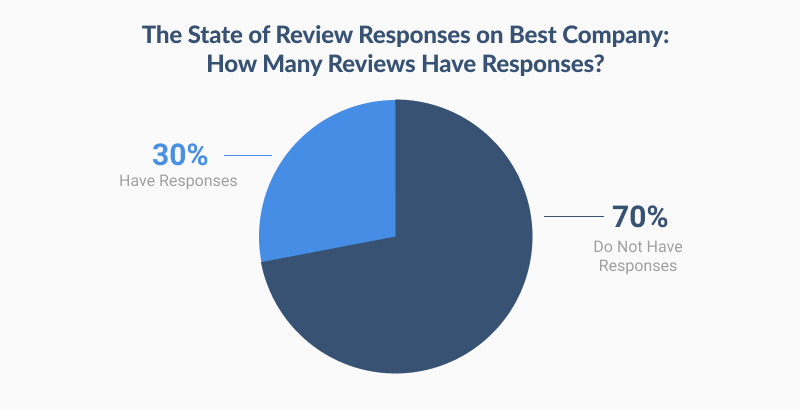
That’s because many businesses on BestCompany.com take their reviews seriously. Here are some of the strategies they use to respond to customers.
Should you use canned or organic review responses?
For large businesses swamped with reviews, canned responses make sense.
Still, three-fourths of the company responses we sampled preferred to keep the message organic:

The messages we considered canned were copy/paste responses with a low level of customization, such as swapping a couple of words or adding a name. If the responder wrote unique sentences for each response, we considered those messages organic, though such responses can be loosely templatized.
Make sure your customer feels seen with your response. There’s nothing more cringeworthy than a canned response opening with “dear valued customer.”
As you can see from the graph, most companies believe customization pays. We agree. Save canned responses for vague feedback or instances where you’re overwhelmed with reviews.
Should you include a CTA in your review responses?
Not every review needs a CTA, particularly if you’re proactively handling the issue. But if you aren’t offering customers a chance to act on their review, they may feel unheard or powerless. For this reason, 42 percent of the reviews we randomly sampled had a CTA within them.
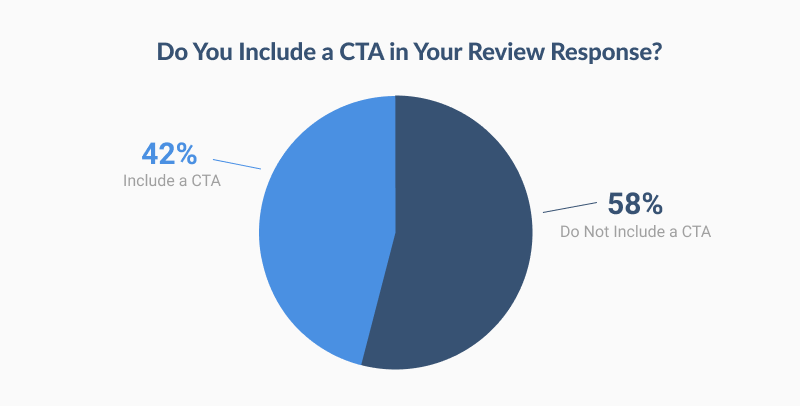
CTAs are most common in negative reviews. Because it’s sometimes difficult to identify the reviewer and reach out privately through their account, companies will respond and request that a reviewer calls or DMs them.
CTAs in positive reviews can come off as salesy, so if you include a call to action in a positive review, make sure it’s not upselling a product or service. But CTAs can have their place in a positive review, reminding the happy customer that you’re there for them.
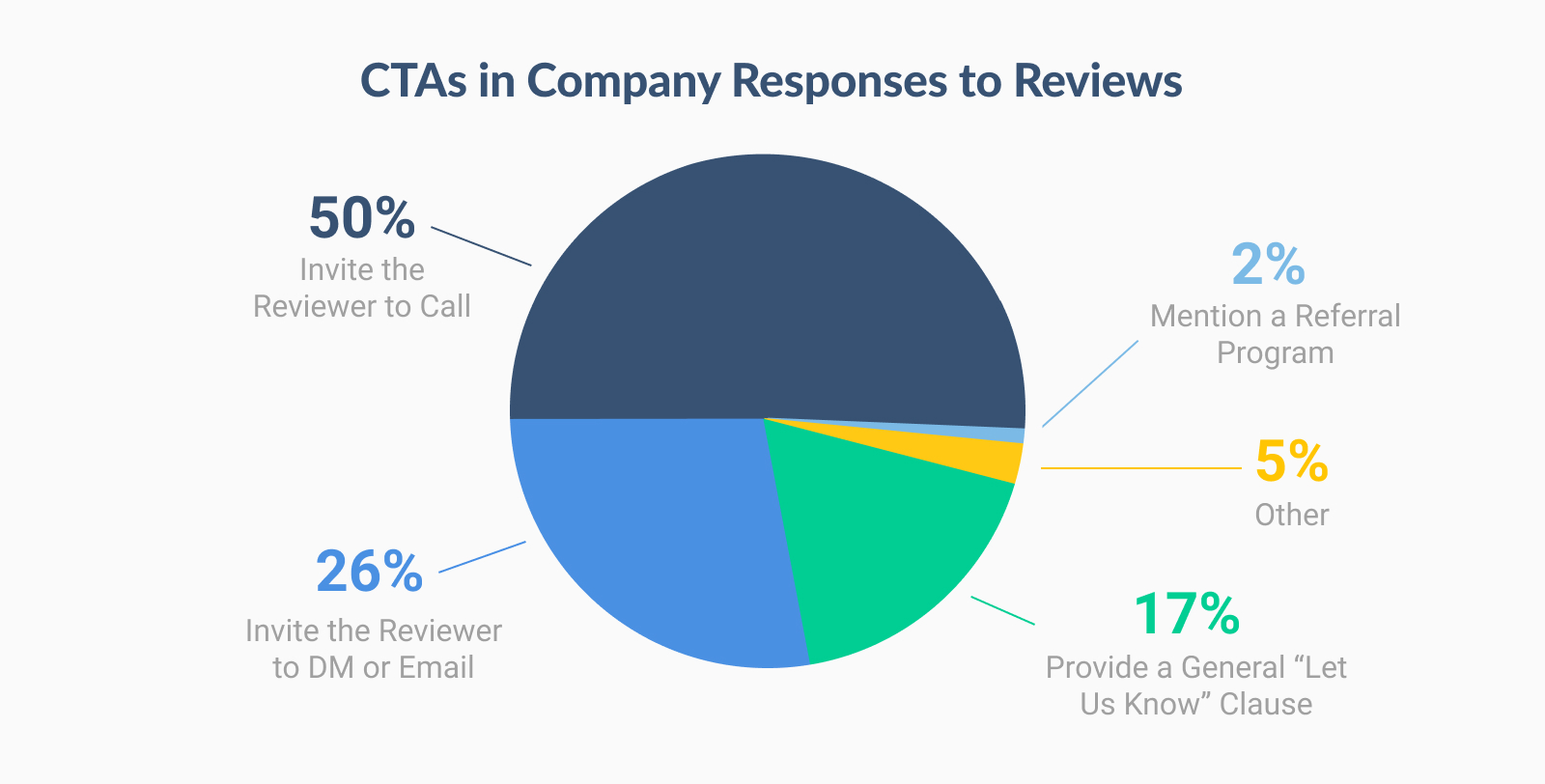
Regardless of whether a review is positive or negative, consider including a CTA to invite customers to continue their relationship with your business.
Should you apprise a reviewer of your resolution?
Naturally, companies want to apprise negative reviewers of a resolution: 72 percent of responses to negative reviews detail what the company is doing to respond to the reviewer’s concerns.

As we detail best practices for responding to negative reviews, keep this in mind. Reviewers like to know how their case is being handled.
Should you respond publicly or privately to reviews?
While this is more difficult to track with data, a common trend for many companies is balancing their public and private responses.
Since reviews are posted publicly, it makes sense to respond publicly so review readers know you’re handling customer issues and are committed to supporting customers.
However, sometimes you may want a dual private and public response approach. To avoid a long-winded response to a negative review or to prevent things from getting messy with a complaint, you may reach out privately to an angry customer to resolve their issue while still posting publicly so review readers can see that you’ve contacted the writer.
Whether you’re capable of responding both privately and publicly will depend on the review platform. BestCompany.com allows both.
Should you assign someone to respond to reviews?
It’s clear when companies have an employee dedicated to review response or a policy outlining how to write a response, these practices create a consistent brand voice. Businesses that have review policies appear more professional.
Create an action plan detailing who will respond to reviews, your goals for review response, which channels are appropriate for escalating a review’s feedback, and when it is appropriate to respond to a review.
If necessary, draft response templates or gather examples for responding to reviews. This will allow the task to be passed off easily.
How frequently should you respond to reviews?
This answer varies by business.
Remember that nearly a third of reviews on BestCompany.com have a response. Some companies don’t respond to reviews at all, while others respond to each one within a few days of the review posting.
Your organization will have its own goals. Settle on a realistic response rate for your workload and decide whether to prioritize responding to every review or only the most urgent reviews.
Most experts agree that the more responses you can make, and the more timely they are, the better.
How to respond to positive reviews
Responding to a positive review should be as easy as a quick “thank you,” right?
Not exactly. While responding can be that simple, positive reviews have more opportunity to retain a customer and leave an impression.
When we sampled reviews on BestCompany.com, we found over 70 percent were positive. It’s important to learn how to respond to a happy customer, because there’s a good chance they make up the bulk of your reviews.
What to do
Here’s what can help you respond to a positive review:
- Respond publicly — Leave a public comment and let the reviewer and readers know you care.
- Thank your reviewer — Gratitude goes a long way.
- If you templatize, leave a couple of sentences to personalize the message.
- Share the review with your staff — Reviewers will love to know you’ve passed on the compliment.
- Include a CTA — This can be anything from leaving customer service’s contact info to mentioning your referral program. Whatever you include, avoid being too salesy. If you include a CTA about a new product to a sea of positive reviews, this will discourage potential clients reading your reviews.
You don’t need to use every tip. Pick the ones that make the most sense for your company. For example, maybe you don’t include a CTA when you’re responding to a positive experience with one of your employees.
What not to do
- Use an obvious template — This may hurt your customer’s impression rather than help.
- Respond privately — Since it’s more valuable for review readers to see your comment, make the response public.
Let’s see some examples of how companies synthesize the best practices in their responses.
Examples
A Personalized Comment

This review response follows best practices by thanking the reviewer, reinforcing his personal, positive experience, and including a CTA to phone customer support if he needs anything.
This business includes a similar CTA in most positive reviews, but ensures its reviews are organic enough that each reviewer feels personally validated.
An Employee Shout-Out

Here, the company receives praise for a specific employee and handles it well, acknowledging the employee and thanking the customer for their review.
A Simple “Thank You”

This business keeps its response to positive feedback simple. This type of response is particularly helpful if you receive an overwhelming number of reviews but want to keep in touch with your customers.
How to respond to negative reviews
While responding to positive feedback is important, addressing your complaints is even more crucial. If you’re pressed for time and can only handle one type of review, ensure the unhappy customer and review readers that you’re handling the situation.
What to do
Responding to a negative review doesn’t have to be complicated. Follow these principles to create a plan of action:
- Assess the feedback internally — How do you plan to resolve the reviewer’s issues? Who will take action?
- Respond publicly — Potential clients may be reading, and they need to know how you handle the criticism.
- Sympathize with the customer — An apology goes a long way. You can also thank the customer for their feedback.
- Let the reviewer know what you’re doing — Will you be reaching out privately to speak with them? Have you apprised a manager of the situation?
- Include a CTA — In case you’re responding to someone you can’t identify or contact, give them the opportunity to reach out through direct message, email, or phone call.
- Respond privately for more information — Keep the continuing dialogue off a public forum so you can work one-on-one with the customer.
What not to do
- Use an obvious template — This comes across as disingenuous when review readers can scroll pages of the same review response template.
- Argue publicly — Telling your side of the story may make sense to you, but it can display immature customer service to others reading the exchange.
- Be sarcastic — Responding to a long-winded complaint with a “Thanks for your response” may seem funny to you, but the sarcasm won’t translate to all your potential clients.
- Tell the reviewer nothing about a solution — Even saying “we’ll work on your concern” or “we’ll continue to improve with your feedback” is a better response than nothing.
Examples
A Public and Private Response

This company handles a bad review by first apologizing, then proactively reaching out with a private response, including a CTA for the reviewer to DM them back. This dual private-and-public approach lets us as readers see that the company is not ignoring its customer while connecting one-on-one with the reviewer.
Requesting More Information

This negative review response includes a CTA for more information to help identify the reviewer. Despite not having the full details, the business account still expresses sympathy and offers an apology.
How to respond to neutral and mixed feedback reviews
The middle ground is where some of your most valuable feedback hides. Future customers value neutral reviews highly for their information, which usually includes detailed pros and cons with a more leveled viewpoint. You should value them, too.
Here’s how you can respond to impress potential clients and the reviewer.
What to do
- Thank the reviewer — Take this opportunity to recognize their positive feedback and express appreciation it.
- Address their concerns — Whether you’ll be reviewing their negative feedback internally or have an explanation for why your product doesn’t include a feature, confront their issues and explain how you plan to help.
- Invite the customer to voice their feedback in an appropriate channel — Publicly comment with a customer service number they can call, or perhaps privately reach out with a link to a survey or form to report bugs.
- Work to resolve their complaints — Then, if you’ve solved their issue(s), reach out privately and request a rescore.
What not to do
- Make excuses — You can explain why their issue may exist in your response, but don’t shift blame.
- Immediately request a rescore — Only do this after you take the time to resolve their issue.
Examples
Weighing the Pros and Cons

The company addresses the client’s concerns and praise in the same order they’re written. First, they apologize for the bad experience and express sympathy. Then, they highlight the turnaround leading to the positive experience. Finally, the business closes with a CTA to call so they can understand more.
This response doesn’t shy away from what may be an awkward phone call: the customer feedback is important.
A Rescore Reminder
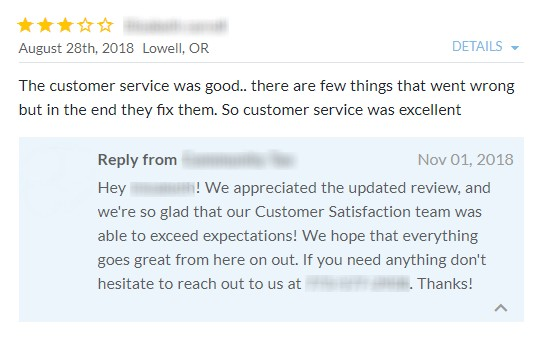
Here, it’s clear the business made an effort to improve the customer’s bad experience. But the only reason that’s apparent is because the business mentions the rescore in their response. This review response will impress readers who now know that the company prioritizes customer satisfaction.
If you want to learn more about how to request a rescore when following up with a review, jump to the rescore section.
A Brief Explanation
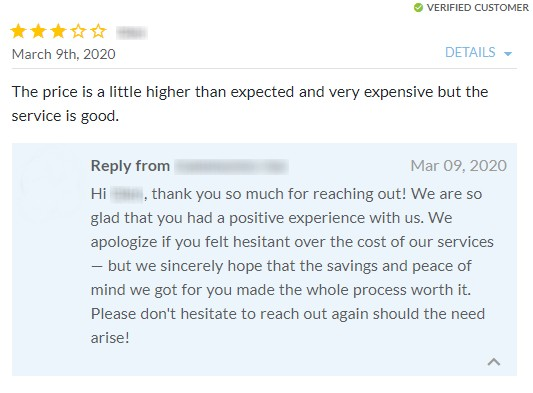
Remember, we encouraged review responders to not make excuses in the “What Not to Do” section. This response is an example of a simple explanation that makes no excuses for itself. The response includes an apology, gratitude for the feedback, and reminder to reach out if the customer needs anything else.
How to dispute fake reviews
Though likely the rarest type of review, a fake review can happen. Fake reviews come from angry customers or competitors, and it’s important to learn how to spot them and respond.
Businesses have recourse if they’re targeted by false reviews. On BestCompany.com, our moderators check each review before it goes live to filter out duplicates or fakes. Other platforms have less moderation, and more fake reviews can slip through the cracks. However, most platforms have a dispute process.
What to do
Below are a few best practices for disputing reviews.
- Comment publicly — As with other types of reviews, responding to a fake review ensures any potential customer reading reviews that you’re handling the situation.
- Reach out privately to identify the reviewer — A private response is a chance to get the customer’s account number, address, or any other information to verify they’re actually a customer.
- Wait for a response — The reviewer may be real after all, and they deserve a grace period to prove it.
- Check the platform’s dispute guidelines — See if your situation qualifies.
- Flag the review if you don’t receive a response from the reviewer — If the review platform requires proof that the reviewer said something false, have this ready.
What not to do
- Publicly accuse reviewer — You can ask the customer to send over their information so you can find them in your CRM, but accusing the writer may concern readers and agitate the reviewer.
- Ignore the review platform’s guidelines — One of the best things you can do for your case is understand the dispute process so your dispute goes smoothly.
How to request a rescore in your response
What if all your critical reviews held some opportunity? This is how businesses need to view a healthy dose of negative feedback.
Some bad reviews have information about your growth opportunities. Other bad reviews simply inform readers your profile is unbiased and contains both positive and negative viewpoints.
And lastly, some negative reviews are an opportunity to improve the customer’s experience and change their mind.
So how do you request a rescore in a review response? It’s a delicate situation.
What to do
- Work with the reviewer via private response — Reach out privately to resolve the issue.
- Escalate the issue through your internal channels — Find out who can help you improve this customer’s experience.
- Once you’ve reached a resolution, request a rescore — Give the reviewer instructions or even provide a link to make the process easy for them.
- Publicly thank the reviewer for rescoring — If the reviewer’s star rating has changed at all, this will notify readers it’s due to your customer service.
What not to do
- Publicly request a rescore — This comes across as disingenuous to review readers who can’t see that you’re working with the reviewer behind the scenes.
- Immediately request a rescore — If the reviewer thought you deserved a higher score, they would have rated you better. You’ll need to put in the work before you ask if their opinion has changed.
- Incentivize a rescore — Money or a coupon may be a quick fix, but incentivizing is against the rules for most review platforms. Money could be part of your resolution, such as correcting an invoice or refunding a purchase, but clarify with the reviewer that compensation is not tied to whether they improve their review.
Want to gather honest reviews from your customers?
Learn how Snoball can help you manage your online reputation and follow up with your verified customers. Schedule a demo today and claim your free account.
Schedule a Demo